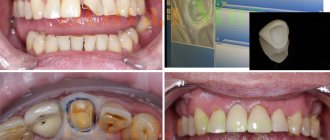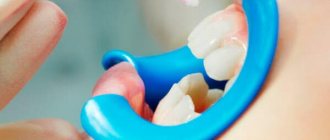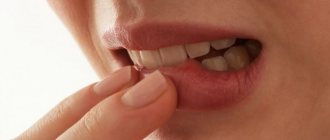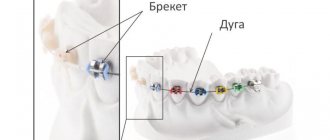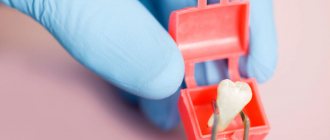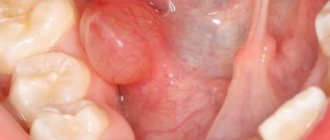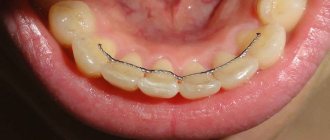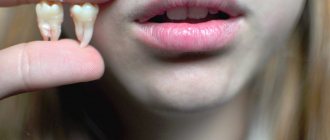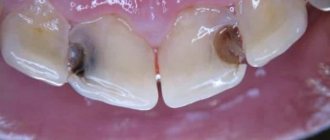4069
Bracket systems intended for the correction of defects, first of all, must meet quality requirements - be resistant to mechanical loads and have sufficient adhesion to the enamel.
In most cases, owners of the structure operate it for the entire allotted period.
However, sometimes something bad happens - the bracket comes off. What to do in this situation, how to prevent the orthodontic element from detaching?
Why do braces come off?
In the process of correcting a bite, such a nuisance as a loose bracket cannot be ruled out. Most often it occurs unexpectedly due to violations of the rules of care and wearing of the leveling apparatus. The patient himself is not always to blame for what happened. The main reasons why a brace comes off:
- Features of the location of the teeth - the part may fly off or come off due to the abnormal force of pressure on individual teeth, which is formed when there is insufficient space for installing braces. This usually occurs in people with severe crowding of teeth and with jaw deformation several days or weeks after fixation of the system.
- Improper care - sudden movements with a toothbrush or brush can cause damage to the elements of the arch during cleaning.
- Dietary disorders – orthodontic treatment is incompatible with certain foods, such as sticky and chewy foods, hard and rough foods. When prohibited products are consumed, the leveling bracket is subjected to strong pressure, which causes it to break.
- Poor-quality glue - sometimes the cause of braces coming off is uncertified materials intended for their installation. In this case, it is recommended to change the specialist or go to another clinic.
Important!
If you systematically violate the rules prescribed by the orthodontist, a situation in which the brace falls off will not be uncommon.
What to do if the arc flies out in another place
If the arch on the braces is bent or broken, or pops out in any other place except the last bracket, then you won’t be able to do anything on your own. You should contact an orthodontist as soon as possible. Delay will lead to distorted results of correction, as well as to extension of treatment time. Wax is applied to a piece of the broken element of the correction system in order to prevent injury to the mucous membrane.
Important!
Sometimes a situation arises when a piece of the bow is swallowed. In this case, it is necessary to call an ambulance, especially if pain is felt, and until it arrives, minimize movements, do not eat anything, do not try to push the element through the esophagus, and do not induce vomiting.
Is it possible to walk with a broken brace?
Braces are a single and complex mechanism. When one component comes loose, the functionality of the entire bracket is impaired. Therefore, it is important to visit an orthodontist as soon as possible if damage occurs.
Important!
If you continue to walk around with the brace unstuck, even on one tooth, then all the efforts previously spent on correcting the bite and uneven teeth will be in vain. A broken structure is deprived of the necessary strength and directional pressure, becoming useless or even causing damage to the jaw.
Mobility of structural elements
If the rules for caring for the oral cavity while wearing braces are violated, the brace structure itself may become loose. In fact, it feels like shakyness.
A common cause is the opening or displacement of the lock, or deformation of the arch. Sometimes loosening is caused by removing the ring, which is designed to fix the structure on the distant molars. If a corresponding symptom appears, you should immediately consult a doctor to eliminate the defects.
If it is not possible to visit the clinic, the structure is secured with orthodontic wax.
But you shouldn’t delay your visit to the doctor; such a violation of the normal structure of the brace system can lead to a change in the distribution of the load, which in turn provokes complications.
Most often, if the structure is unstable, replacement of the entire system is not required. This happens mainly when the lock comes off. In this case, technology involves replacing it. Sometimes patients, if they want to save money, ask the doctor to glue the old one back on. But this is not justified; the likelihood that it will come off is very high.
During production, a new lock is coated with a special compound that increases adhesion. Its activity is lost after the first gluing and upon repeated fixation, the reliability of the structure becomes less reliable.
It is important that when reinstalling, the surface of the lock and the problematic element is carefully treated, excluding the presence of old glue.
During the treatment process, the doctor removes the remaining glue from the tooth and installs a new lock in place.
What to do if your braces come off?
There is no need to panic if the bracket comes off on its own and is hanging on the arch; it is important to seek help from a specialist if the situation occurs during the day. He will check the integrity of the structure, take the necessary measures and suggest what can be done to avoid a similar situation in the future.
If the staple breaks at night or on a weekend, and there is no way to visit a doctor, you need to:
- use tweezers or a toothpick to pick up the ligature and remove the bracket yourself;
- if we are talking about a self-ligating system, simply open the locking lock;
- It is easier to perform manipulations on the front tooth; when the structure on the last tooth comes off, you may need the help of a loved one.
It is not advisable to throw away or lose a removed bracket. It needs to be taken and shown to the doctor so that he can determine further tactics of action.
Important!
If the braces cannot be removed, then it is better not to do anything until visiting the orthodontist. An element dangling in the mouth will cause discomfort, but as soon as a specialist intervenes in the situation, the problem will be eliminated.
Fixation on the outer teeth
Unsticking of braces on the last teeth is more common. This usually happens due to the fact that food is chewed in the corners of the jaw and the likelihood of structure failure increases. You need to know exactly what to do if the bracket on the last tooth comes off.
Before removing the ligature, it is recommended to take into account the structural features of different structures. To determine this, it will be enough to look at the mounting method in the mirror. Thus, when using a lingual system, the end of the arch will be hooked onto the last tooth. In this case, it is better not to touch the ligature.
To restore the bond on the outer teeth, the orthodontist will have to remove most of the archwire to clean the surface of the teeth from the old adhesive material. Next, the removed system is reinstalled.
If the design allows you to independently remove a loose bracket, all manipulations should be carried out with extreme caution. Sudden movements will disrupt the fixation of the rest of the structure. Due to limited access to sevens and eights, retrieving slipped items can be challenging.
Self-gluing of braces and consequences
If there is more than a day left before visiting the doctor, you can temporarily fix the loose bracket on the tooth with special dental wax. But this step will only relieve physical discomfort and the risk that debris from the structure may unexpectedly jump off during sleep, but in no case does it solve the problem.
Wax is not an adhesive for braces; using it at home will not return the previous degree of fixation of the entire system to the dentition; the effect of the orthodontic apparatus still remains impaired.
Important!
If you hesitate to see a doctor and continue to “repair” the braces yourself, the teeth will begin to move to their original position, and wearing a broken brace can cause injury to the oral cavity.
Problem after fixing systems
When the bite is straightened using any orthodontic system, quite a lot of pressure is created on the dentition. This allows the teeth to be moved to a predetermined position.
The process may be accompanied by the occurrence of loose teeth. This happens for a short period of time and is a sign that the arrangement of the elements of the dentition is changing.
The symptom is explained by the fact that the teeth are connected to the bone tissue by a ligament. The latter is held in a certain place, thanks to the dense structure surrounding it, and it is this that prevents loosening.
When the elements of the jaw arch are tilted in a certain direction, the pressure leads to a decrease in density. This leads to the fact that the teeth, on which the maximum pressure is exerted by the structure, become loose.
If such a phenomenon is insignificant, then it can appear during the entire period of wearing the braces system and at the same time remain the norm. When the teeth take the desired position, the phenomenon of unsteadiness should disappear.
After the structure is removed, the density of the tissues increases, thereby securing them in the new position.
Is a whitening procedure always required after braces and which method is best to use?
Come here if you are interested in whether it is possible to correct bite defects with fake braces.
At this address https://zubovv.ru/ortodontiya/breketyi/vestibulyarnyie/esteticheskie-avalon.html we will consider in detail the design of Avalon braces.
Tooth loss during and after braces
If your teeth are loose, braces are not recommended. You must first determine the causes of this symptom and get rid of them. Braces can only be placed on a healthy jaw.
Sometimes it happens that teeth fall out after braces. This problem is faced by patients who had jaw pathologies before the installation of corrective plates. In this case, the dentist chooses the further treatment method. It is necessary to first establish and eliminate the cause of the loss, restore the evenness of the row and perform prosthetics.
What harm can a loose brace cause?
Braces are a complex orthodontic structure used to correct dentition.
They need to be worn from several months to several years: the duration of use is determined individually and depends on the patient’s age and the degree of curvature of the teeth.
With the help of a braces system, you can correct the bite not only in childhood; such designs are also effective in adults.
Since any orthodontic appliances are designed to be worn for a long time, you need to be prepared for the fact that troubles may happen to them from time to time.
The problem with braces in this regard is that the bracket can fall off or break. Of course, this doesn't happen without reason.
Each bracket is attached to the tooth using a special adhesive. The ligature of the braces is pulled tight, creating pressure on the teeth.
Thanks to this pressure, the teeth are aligned. Sometimes the pressure may be too strong and if the movement is unsuccessful, the staple may come off.
You can eat sweet, sour, salty foods - the food will not have any effect on the adhesive composition. The glue can also withstand changes in temperature.
Neither eaten ice cream nor hot tea can cause the braces to come off.
However, despite the characteristics of the adhesive composition, sometimes braces come off. Very hard or viscous foods can contribute to this.
While wearing braces, you should refrain from using:
- crackers;
- drying;
- fresh hard vegetables (carrots, celery);
- toffee;
- chewing marmalade;
- chewing gum.
Thorough brushing of teeth also helps prevent the brackets from coming off, since the tightness of the connection with the enamel can be impaired due to an inflammatory disease of the tooth or gum.
Brackets can also come off if there is not enough space in the mouth, when adjacent braces or fastenings of another jaw come into contact.
As your teeth straighten, you need to regularly visit the dentist and adjust the appliance.
If you initially follow all the doctor’s recommendations and follow the rules for caring for and wearing braces, then the likelihood of this happening is much less. But the risk always remains. Why do braces come off? This is often the result of injury, careless actions or high load. Let's try to highlight the main reasons why the bracket can come off.
- At the very beginning of treatment, increased stress is placed on the teeth. It is especially strong for crowded teeth. Excessive pressure can cause braces to come off.
- Immediately after installation of the orthodontic structure, the doctor gives nutritional recommendations. First of all, it is necessary to exclude from the diet foods that are too hard and rough: nuts, crackers, hard fruits. Violation of this rule is the most likely reason for the elements of the bracket system to come off.
- Brushing your teeth while wearing orthodontic appliances becomes more difficult. There is a need to use additional devices: brushes, floss, irrigator. They must be used carefully, as too sudden movements may cause the bracket to fall off.
Crooked teeth and wide interdental gaps are corrected with the help of braces, which make it possible to straighten the dentition thanks to long-term directed pressure on the dental units. Braces are attached to the teeth with special glue. If you notice structural elements that have come unglued for some reason, you cannot ignore the problem.
After installing the structure, you need to carefully examine the entire system and its elements in front of the mirror. You must be able to explain any negative changes or inconveniences that have arisen, even over the phone to the clinic administrator or your doctor: an archwire has popped out, a brace has come off, or uncomfortable symptoms have appeared. Having understood the problem that has arisen, they will tell you what to do and make an appointment for an urgent (unscheduled) appointment, if necessary. Therefore, you need to know the basic elements of the design.
The orthodontic arch is given the shape of the correct dentition and its purpose is to put pressure on the dental units to align them in the correct position. As treatment progresses, the arches are changed, adjusting their shape. The arch in the grooves of the braces is fixed with ligatures (elastic elements made of various materials). Over time, they stretch and are replaced every 4-5 weeks with new ones to seal the connection between the arch and braces. Metal ligatures are also used, which fix the arc more securely and tightly.
The tails of such ligatures are bent towards the teeth; the tip that is bent and scratches the lip can be bent independently with a toothpick. Fixed elements (braces) are glued with a special composite material (containing fluoride to prevent enamel demineralization) to the outer or inner surface of the teeth.
The function of the bracket on each dental unit is individual; it is designed to orient the tooth in 3 dimensions, transferring pressure from the arch. It consists of a base, a groove and wings (2 or 4); there may be an additional hook on the wings. An arc is inserted into the groove and secured with ligatures. Violation of any element must be eliminated, otherwise the long and painstaking treatment process can be nullified.
Metal braces come off much less often than plastic and ceramic ones. You cannot continue to use the bracket system if (at least one) element has come off. The bending of the arch and the distribution of the load on each tooth in the row are carefully calculated using a special computer program. Uniform pressure on the teeth is disrupted and this can lead to negative consequences.
If your braces come off, try not to panic. But you shouldn’t relax either. Your quick reaction and quick adoption of measures to solve this problem is the key to the correct and competent continuation of the course of wearing braces. Long-term use of even a partially peeled-off element of the system can lead to unpleasant consequences for you, since uniform pressure on the teeth is disrupted.
- If the problem occurred during the day, try to immediately contact your orthodontist and schedule an unscheduled appointment. The doctor will check how the rest of the system is attached and whether there are other problematic elements. In addition, the orthodontist will advise you on what to do and how to behave in such a situation before you see him.
- Don't worry if a brace falls off at night or at an inconvenient moment for you. After identifying the problem, the first thing you need to do is try to get tweezers with which you need to pick up the ligature. As a last resort, use a toothpick for this purpose. Once freed from the ligature, remove the bracket itself. If the device you are wearing is ligature-free, then you should simply open the locking clasp.
- Do not throw away a loose bracket. Take it with you to your doctor's appointment. The specialist can install a new bracket, or can re-glue the unglued element.
DETAILS: How an orthodontist inserts braces
So why do braces come off? There may be several reasons for this:
- the lock was initially glued incorrectly;
- something hard was eaten;
- aggressive brushing of teeth provoked peeling;
- the lock was glued to the crown;
- characteristics of the body.
Read more about the last point. Every organism in this world is unique, and no doctor, even the best one, can predict 100% how the teeth will behave after installing braces. How quickly they will move, how often and severely they will hurt, whether they will come off - one can only guess about the answers to all these questions.
Therefore, the reason why the brace constantly comes off can be surprisingly simple - this is how the body reacts to a foreign body.
In addition, the teeth may not have enough space in the mouth, and the braces may bump into each other and come into contact with each other. All this can also lead to the braces coming off.
Often, braces are installed not on a “clean” tooth, but on a crown. This is not prohibited; sometimes orthopedists even install a crown specifically for treatment with braces. But the brace may not stick as well to the crown as it does to the tooth. This is due to the fact that the glue on which the clasp is placed has poorer contact with the artificial material, so the clasps come off the crowns more often. This situation is no different from any other, and the patient has no choice but to visit his orthodontist.
Naturally, peeling off the elements of the bracket system brings a lot of discomfort, which must be eliminated as soon as possible. But beyond simple inconvenience, this situation can negatively affect the effectiveness of the orthodontic appliance. Due to the fact that one of its elements is deformed, the pressure begins to affect the teeth unevenly. This makes braces useless and over time the reverse process begins, the bite returns to its previous position or is bent arbitrarily.
